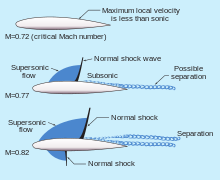24:
225:
193:
131:, in some airplanes, the speed of the air over the top surface of the wing may be double the airplane's airspeed. It is, therefore, entirely possible to have both supersonic and subsonic airflows on an airplane at the same time. When flow velocities reach sonic speeds at some locations on an airplane (such as the area of maximum
93:(the property of a fluid that tends to prevent motion of one part of the fluid with respect to another) are negligible, and classifies air as an ideal fluid, conforming to the principles of ideal-fluid aerodynamics such as continuity,
197:
101:. In reality, air is compressible and viscous. While the effects of these properties are negligible at low speeds, compressibility effects in particular become increasingly important as airspeed increases.
70:
below about 260 kn (480 km/h; 130 m/s; 300 mph), air can be considered incompressible in regards to an aircraft, in that, at a fixed
266:
148:
165:. U.S. Government Printing Office, Washington D.C.: U.S. Federal Aviation Administration. 2003. pp. 3–35. FAA-8083-25.
175:
98:
259:
185:
208:
94:
290:
119:
produces lift by accelerating the airflow over the upper surface. This accelerated air can, and does, reach
252:
52:
132:
104:
Compressibility (and to a lesser extent viscosity) is of paramount importance at speeds approaching the
17:
180:
144:
66:
is based upon the forces generated on a body and a moving gas (air) in which it is immersed. At
135:
on the wing), further acceleration will result in the onset of compressibility effects such as
285:
160:
236:
140:
112:
speed ranges, compressibility causes a change in the density of the air around an airplane.
128:
48:
23:
105:
56:
279:
151:
difficulties. Subsonic flow principles are invalid at all speeds above this point.
63:
59:
82:
varies. Under this assumption, air acts the same as water and is classified as a
124:
36:
32:
202:
136:
123:
speeds, even though the airplane itself may be flying at a subsonic airspeed (
120:
109:
90:
224:
232:
79:
71:
67:
16:
This article is about the aerodynamic phenomenon. For the RAF unit, see
75:
28:
83:
22:
116:
89:
Subsonic aerodynamic theory also assumes the effects of
240:
260:
8:
267:
253:
204:Pilot's Handbook of Aeronautical Knowledge
162:Pilot's Handbook of Aeronautical Knowledge
7:
221:
219:
239:. You can help Knowledge (XXG) by
78:remains nearly constant while its
14:
223:
196: This article incorporates
191:
27:Transonic flow patterns on an
1:
176:Coffin corner (aerodynamics)
186:Drag divergence Mach number
127:< 1.0). At some extreme
307:
218:
139:formation, drag increase,
15:
39:(M) in high-speed flight.
31:showing the formation of
209:United States Government
235:-related article is a
198:public domain material
53:low-speed aerodynamics
40:
95:Bernoulli's principle
55:no longer apply. In
47:, the assumptions of
26:
18:High Speed Flight RAF
181:Critical Mach number
51:of the air used in
41:
248:
247:
115:During flight, a
49:incompressibility
45:high-speed flight
298:
269:
262:
255:
227:
220:
212:
195:
194:
166:
129:angles of attack
62:, the theory of
306:
305:
301:
300:
299:
297:
296:
295:
276:
275:
274:
273:
216:
213:
201:
192:
172:
159:
157:
21:
12:
11:
5:
304:
302:
294:
293:
291:Aviation stubs
288:
278:
277:
272:
271:
264:
257:
249:
246:
245:
228:
189:
188:
183:
178:
171:
168:
156:
153:
106:speed of sound
13:
10:
9:
6:
4:
3:
2:
303:
292:
289:
287:
284:
283:
281:
270:
265:
263:
258:
256:
251:
250:
244:
242:
238:
234:
229:
226:
222:
217:
214:
210:
206:
205:
199:
187:
184:
182:
179:
177:
174:
173:
169:
167:
164:
163:
154:
152:
150:
146:
142:
138:
134:
130:
126:
122:
118:
113:
111:
107:
102:
100:
96:
92:
87:
85:
81:
77:
73:
69:
65:
61:
58:
54:
50:
46:
38:
35:at different
34:
30:
25:
19:
241:expanding it
230:
215:
203:
190:
161:
158:
114:
103:
88:
60:aerodynamics
44:
42:
37:Mach numbers
125:Mach number
108:. In these
99:circulation
33:shock waves
280:Categories
137:shock wave
121:supersonic
145:stability
141:buffeting
110:transonic
91:viscosity
68:airspeeds
286:Airspeed
233:aviation
170:See also
80:pressure
72:altitude
57:subsonic
155:Sources
149:control
76:density
29:airfoil
147:, and
133:camber
97:, and
74:, its
231:This
200:from
84:fluid
237:stub
117:wing
64:lift
43:In
282::
207:.
143:,
86:.
268:e
261:t
254:v
243:.
211:.
20:.
Text is available under the Creative Commons Attribution-ShareAlike License. Additional terms may apply.
